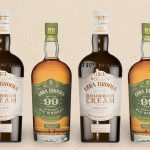 Virtually any anthology of American poetry will have a poem or two from Eugene Field (1850-1895), an author and editor of newspapers ranging from Denver to Chicago. Known for his practical jokes and dislike of prohibition, when in his home town of St. Louis, Field regularly found his way to a saloon run by a German immigrant named John Henry Bloeser. Bloeser’s “watering hole” was well known in St. Louis as a hang-out for politicians and literary types.
Virtually any anthology of American poetry will have a poem or two from Eugene Field (1850-1895), an author and editor of newspapers ranging from Denver to Chicago. Known for his practical jokes and dislike of prohibition, when in his home town of St. Louis, Field regularly found his way to a saloon run by a German immigrant named John Henry Bloeser. Bloeser’s “watering hole” was well known in St. Louis as a hang-out for politicians and literary types.
 The son of a nationally known attorney, Field spent his early boyhood in St. Louis where his home, shown here, now is a museum dedicated to his memory. After his mother’s death when he was six, he was raised by an aunt in Amherst, Massachusetts. Following a feckless college career, Field rejected law in favor of journalism. Field’s first major post was as the city editor of the St.Joseph, Missouri, Gazette where he made a name for himself as a writer and found a bride in sixteen-year-old Julia Comstock. They would have eight children. By 1876 he was back in St. Louis writing editorials for the St. Louis Journal.
The son of a nationally known attorney, Field spent his early boyhood in St. Louis where his home, shown here, now is a museum dedicated to his memory. After his mother’s death when he was six, he was raised by an aunt in Amherst, Massachusetts. Following a feckless college career, Field rejected law in favor of journalism. Field’s first major post was as the city editor of the St.Joseph, Missouri, Gazette where he made a name for himself as a writer and found a bride in sixteen-year-old Julia Comstock. They would have eight children. By 1876 he was back in St. Louis writing editorials for the St. Louis Journal.

 It was there that he met John Henry Bloeser, a German immigrant who had arrived in the United States in the mid-1860s, living first in Chicago and after his marriage in 1872, moving to St. Louis. There he opened a saloon at Pine and Eighth Streets, shown here. His drinking establishment soon became a hangout for the newspaper and literati crowd. Field was among Bloeser’s regulars.
It was there that he met John Henry Bloeser, a German immigrant who had arrived in the United States in the mid-1860s, living first in Chicago and after his marriage in 1872, moving to St. Louis. There he opened a saloon at Pine and Eighth Streets, shown here. His drinking establishment soon became a hangout for the newspaper and literati crowd. Field was among Bloeser’s regulars.
Bloeser also was selling liquor at both wholesale and retail calling his company the Bloeser Distilling Company. He was not making whiskey but buying it from distillers and blending it in his facilities to achieve a desired color, taste and smoothness. He used the brand names “Empire Rye” and “Harlem Club” for his blends. Although Bloeser failed to trademark either label, he advertised his whiskey widely though shot glasses and corkscrews.


 The publican must have missed the steady patronage of Eugene Field when he left St. Louis in 1880. After spending a short time as managing editor of the Kansas City Times Field landed a similar position with the Denver Tribune. In that city he became a customer and confidant of a saloonkeeper named Wolfe Londoner, shown here, a man destined to become a future mayor of Denver. [See post on Londoner, Nov. 26, 2017]. Londoner’s establishment was an unofficial Press Club for the city’s journalists.
The publican must have missed the steady patronage of Eugene Field when he left St. Louis in 1880. After spending a short time as managing editor of the Kansas City Times Field landed a similar position with the Denver Tribune. In that city he became a customer and confidant of a saloonkeeper named Wolfe Londoner, shown here, a man destined to become a future mayor of Denver. [See post on Londoner, Nov. 26, 2017]. Londoner’s establishment was an unofficial Press Club for the city’s journalists.
That did not deter Field from playing a practical joke on his friend. Here is how Londoner told it — and his retaliation: “Gene Field wrote an article, saying that I would present every colored voter who called at my store with a watermelon. They came in droves, all clamoring for melons. Fortunately, I found a wagon of Georgia melons on Market Street and I passed them out. The next day I put an ad in the News that Gene Field wanted a watchdog, and set a time for owners to bring dogs to his office. At the appointed time there was yelping and fighting and scrambling of dogs in Gene’s office. He climbed on a table and screamed for help, while the owners of the dogs fought lustily with each other.”
 Field lasted two years in Denver as an editor. Meanwhile in 1879 he had published his book of first verse entitled “Christmas Treasures,” to be followed by many more poems, such as “Winken, Blinken, and Nod” and the “Gingham Dog and Calico Cat,” both destined to become childhood favorites. Other Field lines were meant to appeal to more mature audiences:
Field lasted two years in Denver as an editor. Meanwhile in 1879 he had published his book of first verse entitled “Christmas Treasures,” to be followed by many more poems, such as “Winken, Blinken, and Nod” and the “Gingham Dog and Calico Cat,” both destined to become childhood favorites. Other Field lines were meant to appeal to more mature audiences:
Not drunk is he who from the floor
Can rise again and drink some more;
But drunk is he who prostrate lies,
And who can nether drink nor rise.
In addition to a cascade of poetry, Field was penning short stories and humorous articles that rapidly brought him a national audience. The Chicago Morning News in 1983 lured him from Denver with a lucrative promise to make him a columnist and poet in residence with no managerial responsibilities. Field snapped up the offer and moved his large and growing family to the Windy City. There he wrote prolifically on a variety of subjects, including his aversion to efforts at banning alcohol production and consumption.
 This view led to a notable incident in Field’s writing career. He had developed an aversion to Rutherford B. Hayes because the former President had refused to serve wine in the White House, possibly at the behest of his wife, known as “Lemonade Lucy” who had embraced prohibition. Although Field admired Lucy, he developed a deep antipathy toward her husband. As a result, when he heard a rumor that Hayes was deriving a substantial part of his income from co-ownership of a saloon in Omaha, Nebraska, he demanded that the News send him and a staff photographer to Omaha to check out the story. The editor reluctantly agreed.
This view led to a notable incident in Field’s writing career. He had developed an aversion to Rutherford B. Hayes because the former President had refused to serve wine in the White House, possibly at the behest of his wife, known as “Lemonade Lucy” who had embraced prohibition. Although Field admired Lucy, he developed a deep antipathy toward her husband. As a result, when he heard a rumor that Hayes was deriving a substantial part of his income from co-ownership of a saloon in Omaha, Nebraska, he demanded that the News send him and a staff photographer to Omaha to check out the story. The editor reluctantly agreed.
 |
| R. B. Hayes |
Field went, found that the story was true, and returned with the proof and a photograph of himself sitting on a keg of beer in Hayes’ saloon. After buying the keg and drinking the contents he had a frame fashioned from the staves for the photo and presented the picture to his editor. The resulting “scoop” about the former President’s apparent hypocrisy made national headlines. Deeply embarrassed by what he called “the Omaha Slander,” Hayes turned to Edward Bok, a well known New York journalist, for help. Bok responded by writing an article for his Brooklyn Magazine defending Hayes’ reputation. In response, Hayes wrote Bok to express his gratitude, commenting about Field’s article: “The abuse of certain people is virtual commendation.” Only later did Hayes admit to Bok that he indeed was co-owner of the Omaha saloon.
From his Chicago base, Field with some frequency returned to St. Louis, possibly to visit relatives, despite once having described it as an “ineffably uninteresting city,” and regularly referring to the state as “poor old Mizzoorah.” According to newspaper reports, when in town he regularly visited Bloeser’s saloon where he presumably found companions who were not entirely “uninteresting.” I fantasize that a Field’s drinking poem may have had this “watering hole” in mind. An excerpt reads:
And you, oh, friends from west and east
And other foreign parts,
Come share the rapture of our feast,
The love of loyal hearts;
And in the wassail that suspends
All matter burthensome,
We’ll drink a health to good old friends
And good friends yet to come.
 Never in good health himself, in 1895 Field died in Chicago of a sudden heart attack at the untimely age of 45. His funeral was held at the Church of the Holy Comforter in Kenilworth, Illinois. Although Field originally was buried in Chicago’s Graceland Cemetery, his son-in-law, an official of Holy Comforter, had him reinterred there a year later. Field’s wife Julia joined him there 41 years later having lived to 80. Their joint monument is shown here.
Never in good health himself, in 1895 Field died in Chicago of a sudden heart attack at the untimely age of 45. His funeral was held at the Church of the Holy Comforter in Kenilworth, Illinois. Although Field originally was buried in Chicago’s Graceland Cemetery, his son-in-law, an official of Holy Comforter, had him reinterred there a year later. Field’s wife Julia joined him there 41 years later having lived to 80. Their joint monument is shown here.
After some 45 years in business the coming of National Prohibition in 1920 forced the closing of John Bloeser’s saloon and liquor store. During its existence he had managed to sire and support eleven children by two wives. The saloonkeeper lived to see the coming of Repeal, succumbing to pneumonia at the St. Louis Altenheim Hospital in April 1934 at the age of 90. Bloeser was buried in Gatewood Gardens Cemetery, shown below. Under the headline “Old-Time Saloon Operator Dies,” Bloeser’s obituary in the St. Louis Post -Dispatch reported: “Mr. Bloeser’s establishments were popular with politicians and literary figures, one of them Eugene Field.”

Note: Shown above, Field’s childhood home in St. Louis is now a museum. The Eugene Field House contains many of his mementos, including original manuscripts, books, furniture, personal effects, and some of the toys that inspired his poems. A key source for this post was the book, “Eugene Field, A Study in Heredity and Contradictions” (1901), written by his friend and fellow journalist Slason Thompson.
















